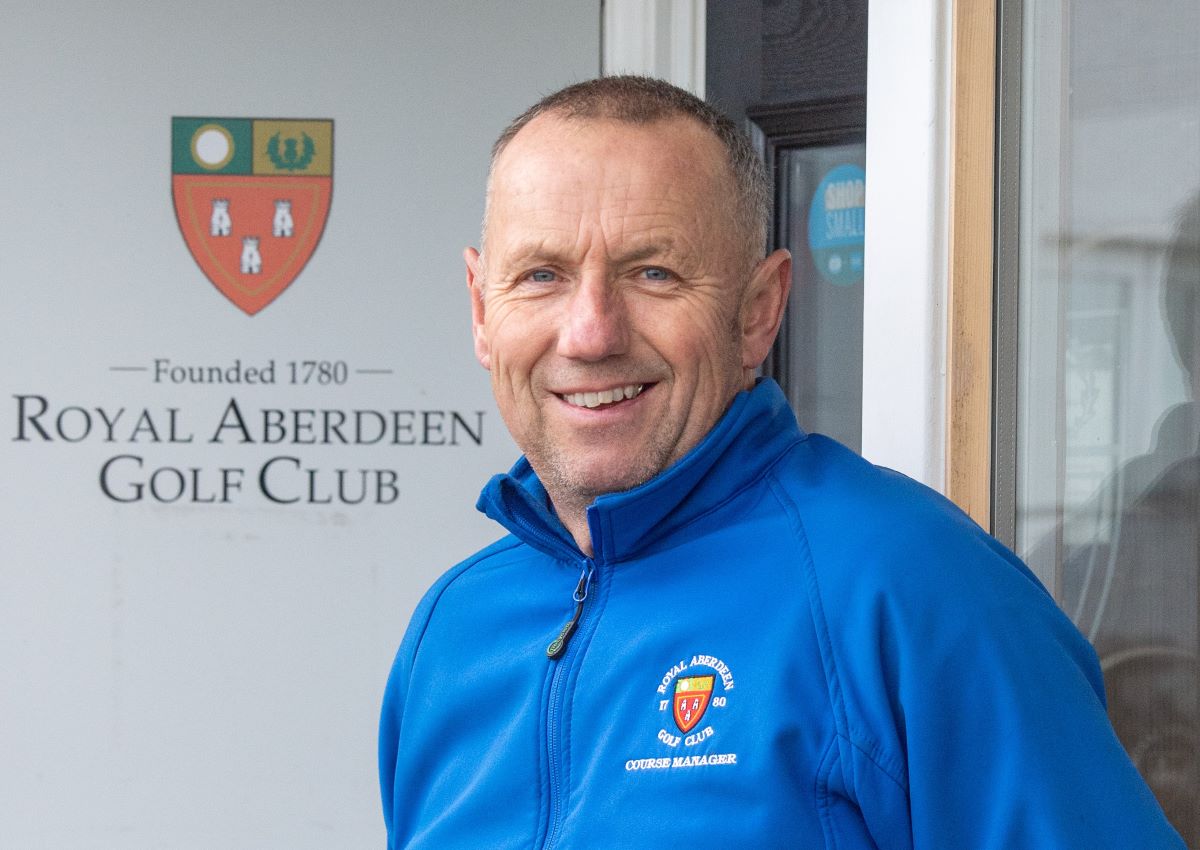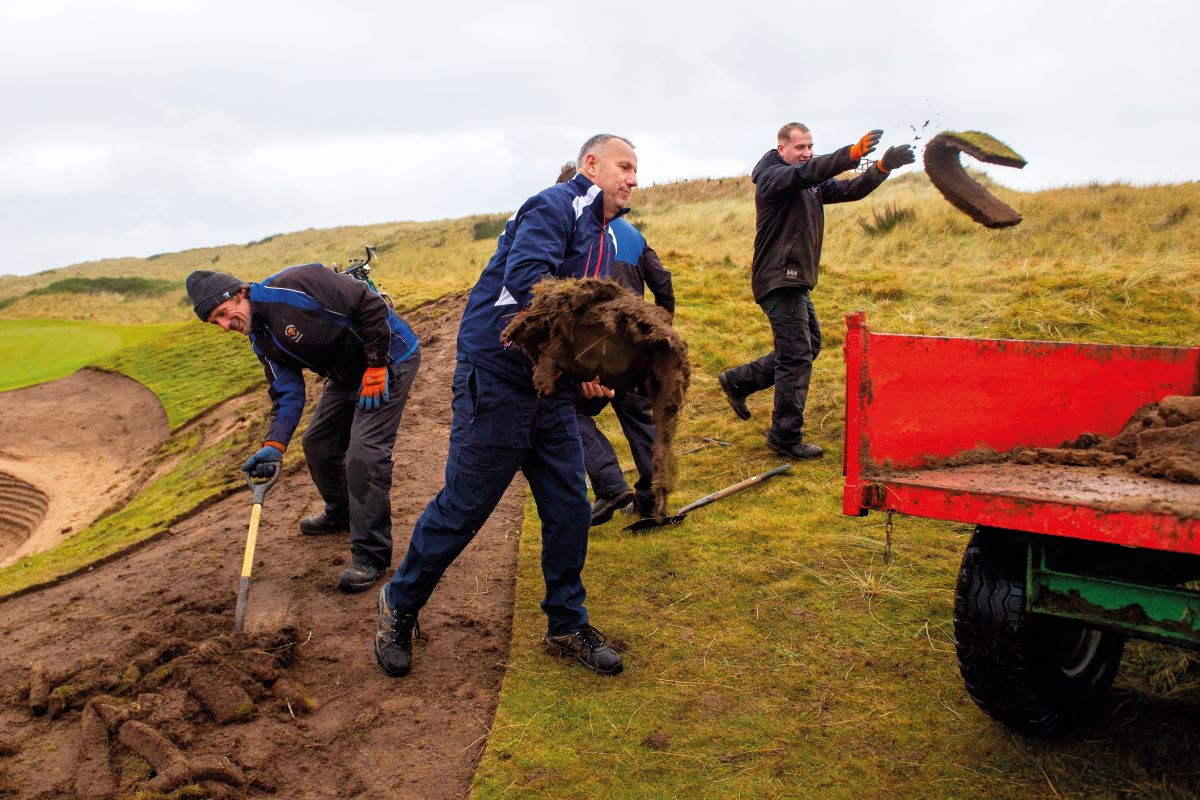- Homepage
- News and Features
- 'It was a chance to work on a golf course, a dream come true' - Robert Patterson's story
'It was a chance to work on a golf course, a dream come true' - Robert Patterson's story
Royal Dornoch’s gravitational pull was always going to prove too strong for Robert Patterson to escape – not that he’d have wanted to.

Robert was born in Dornoch, and the local golf club was the town’s greatest boast, even before the historic links attained the prestige it has now. As soon as he was old enough to leave school, Robert found work there as a labourer. It was a matter of months before he had the opportunity to try his hand at greenkeeping – and he knew immediately he had found his calling. By the age of 22, Robert had ascended to the role of head greenkeeper.
He spent 17 years at his hometown club before making the move to Royal Aberdeen, where he will call time on his long and distinguished tenure as course manager in February next year. After 44 years in the industry, Robert can’t bring himself to leave it all behind just yet, with a “side hustle” in advisory and consultancy work on his radar. Here, he reflects on a life dedicated to his one true passion.
Growing up with Royal Dornoch on his doorstep
It’s a small place, growing now and getting bigger all the time, but when I grew up there in the 70s, the golf club was the main focus for many local people and visitors – there wasn’t an awful lot else to do. There was a slaughterhouse in Dornoch, and a lot of people locally were employed there, but other than that the employment mainly came at the golf club.
You’d play golf there in the summer or you’d caddie. My father was a very keen golfer and as soon as I was old enough, I had a golf club in my hand. I grew up just loving playing golf. I did play football, too, but once I got to about 13 or 14, I really took to golf and soon after that I got the chance to work on a golf course, which was a dream come true.
First steps on the career ladder
I left school when I was 15 – you could leave school at that age back then, which shows you how old I am. My father wanted me to take a job at the forestry as he didn’t want me sitting at home doing nothing, but then I went to Royal Dornoch in 1980 and did three months as a labourer. When one of the greenkeepers was off work with an injury, I got involved just to help out. It was the following year that I was offered an apprenticeship and that was the start of my training at Elmwood College in Fife. I became a fully qualified greenkeeper in 1985.

Head greenkeeper at 22
I was offered the head greenkeeper job at Royal Dornoch in 1987 when I was just 22 years old. I’d done quite well in my time at college and the club was preferably looking to employ someone locally, so they offered me the job. I’ll be honest, I wasn’t really ready to be the head greenkeeper at that age because I didn’t have a huge amount of experience behind me, but there was no way I was turning it down. My thinking was I’d rather try and fail than not try at all.
I won’t deny the first four or five years were quite difficult. It was a steep learning curve to go from being one of the greenkeepers on the Friday to coming in on the Monday as the boss. It was completely different for me having to manage people and plan work, but I have always had a strong work ethic, and I just got on with it. I sought advice from the likes of Walter Woods, Jack McMillan, John Philp and Jimmy Kidd and learned as I went along. I did 11 years there before I moved to Royal Aberdeen as course manager.
When Royal Dornoch wasn’t what it is now
Royal Dornoch is known internationally now in the golfing world, but back then it was a smaller, local golf club. It didn’t have the recognition it does now simply because, at that time, the Americans didn’t know anything about it. It wasn’t until Tom Watson and Ben Crenshaw went there to play it when they were over for The Open in the mid-80s that really started Dornoch on the journey to becoming what it is now. Before that, it was quite a small place, very seasonal; people would come on holiday, stay on the caravan site and play a round of golf.
The challenge facing him at Royal Aberdeen
When I came to Aberdeen, it was a world-renowned links with fantastic terrain, but the course was very run down. There had been a lack of investment, a lack of resources and a lack of proper greenkeeping inputs for many years. It was the ideal situation for me to come into because the only way we could go was up.
From the start, the club said they would like more R&A events. They wanted to get better tournaments at Royal Aberdeen and investing in a new course manager was the start of that process. It was my job to get it by the scruff of the neck and drag it up to where it deserved to be. The R&A had said the course wasn’t long enough for their tournaments, so it needed to be extended, but the condition of it wasn’t nearly good enough to host their events. We then set out plans to revamp the golf course, starting with the greens as they were in terrible condition, and working through basically every surface – approach areas, fairways, tees and rough.
I laid out quite stark plans to the members when I arrived outlining what we needed to do to address the condition of the golf course and get it to the standard it needed to be. It meant a lot of disruption, but there was an acceptance that it had to be done. The club invested in machinery, staff, better sheds, better facilities, and I had the drive to push it on. That was my passion, and I knew what needed to be done, and the club backed me – if we needed something for the golf courses, we got it. We made quite rapid progress in a short time.
Every year, people could see the courses were getting better and better, so it wasn’t difficult to convince the membership and committees of the benefits of doing the next thing and the next thing.
Preparing the course for big events
I had informed the club when I arrived it would take five to seven years to get the greens into a condition to perform as they should for a links course, and it was in 2005 – seven years after I arrived – that we hosted the British Senior Open, which Tom Watson won.
Over many years the club has hosted all of The R&A events bar The Open. From 2005 to 2014, when we had the Scottish Open, we had 12 events in that time. This showed the course was improving to a standard whereby the main golf bodies wanted to come with their events, and it wasn’t just The R&A, it was the European Tour, the Scottish Golf Union and The PGA – they all wanted to come and have an event with us.
As those things came, we got more recognition globally, being on TV, and more people wanted to come and play the course and add Royal Aberdeen to their bucket list.

Why BIGGA matters
I had a much greater involvement with BIGGA after I moved to Royal Aberdeen and ultimately served as regional chairman in Scotland. I came to appreciate BIGGA does far more work than many people realise and how important the organisation is to our industry. They champion greenkeepers and educate people on how important our profession is.
The bottom line is these massive events – The Open, the Ryder Cup, the other big championships – without the golf course they don't happen, and that's the responsibility of greenkeepers. We just have to keep banging that drum, make sure that our voices are heard and that course managers/head greenkeepers are at the forefront of all the major decisions taken within a golf club.
The satisfaction of a job well done
As much as it’s important for the club to have hosted those big events, the satisfaction for me is in seeing where we were on day one to where we are now.
Royal Aberdeen is very much a members’ club, and right from the start I’ve had a great relationship with the membership. I’ve never forgotten that it’s their club and course, so first and foremost that’s our priority. The fact that on the back of all the work we have done, we have been awarded all those events is just the icing on the cake. Obviously to have had the calibre of golfer those events attract walking on our turf is special, but the satisfaction comes from the 25 years of work that has gone into that.
The big events are a justification and validation for all the inputs way back when the place was on its knees. First and foremost, we had to get the golf course into proper links conditions for our members, and everything that came on the back of that was a bonus. The whole infrastructure of the greenkeeping department at this club is set up so that we can host major events at very short notice. If we got asked to do a Scottish Open next year in July, then we could accommodate it with no worries about the golf course or having to do any major things to it. It’s ready all the time and that’s the standard we have set for our members, whatever time of year.

Time for a change
I’m really interested in advisory work and passing on some of the knowledge I’ve gained over the years.
I want to give back to the industry and share what I’ve learned with younger greenkeepers. I don’t want to walk away when I feel like I have quite a bit to offer, and it’s not just about the turf but all areas of managing a golf course. I think it’s important for people to stand up and speak and share that knowledge for the benefit of others. If I can pass a few days a week doing things like that, I’ll be happy; I want to keep the brain active.
I’ll be 60 soon, so I also want to slow down a bit and enjoy life for a wee while. GI
Author

